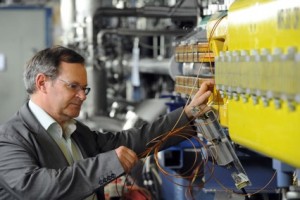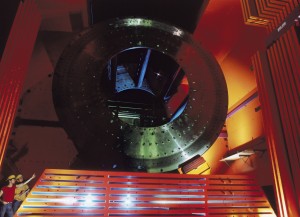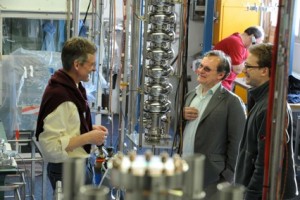
Brian Foster inspects connections on one of the HERA storage ring magnets. Image: © Alexander von Humboldt Foundation / Ausserhofer
When Albrecht Wagner, former chair of the DESY directorate, first suggested to me that I might consider applying for an Alexander von Humboldt Professorship in association with Hamburg University and DESY, I didn’t take the idea seriously. I had no intention of leaving Oxford, which is a fantastic place both to live and to work. Then I looked at the advertisement that Albrecht sent me. I was astonished by the generosity of the scheme, which gives the Professor 1 million Euro a year for five years to spend, without any strings attached, on his or her work. That, together with my long association with DESY and Hamburg, which goes back to my first postdoc thirty-five years ago, convinced me that I should apply. So here I am, sitting in my office in DESY trying to work out how to spend these resources to the greatest effect. I thought I might usefully devote this Director’s Corner to telling you about my plans, since ILC plays a very strong part in them.
Deciding on the optimum research programme is no easy matter, as there are so many fascinating things going on in both particle physics and accelerators that would pay handsome dividends from any investment. I am lucky to have great advice and collaboration from my old friends and colleagues Eckhard Elsen and Nick Walker, whom I signed up to the Humboldt enterprise as soon as I heard that I had been awarded the Prize. The main thrusts of the programme were clear from the outset since they reflect my own interests – activity in both particle physics and accelerator physics and the areas of overlap. My own interests have developed in this way over the last decade or so since I became chair of ECFA and European director of the ILC.

The ZEUS detector, which took data at DESY’s electron-proton collider HERA from 1992 to 2007. Image: DESY / Ginter
In particle physics, I feel that it is extremely important that we extract the maximum possible physics from DESY’s electron-proton collider HERA, since it represents a unique data set and is also vital to extract precision cross-sections and new physics from the Large Hadron Collider (LHC). Furthermore, this work has a rather low profile at a time when everyone naturally wants to work on the exciting vistas opening up at LHC. At this stage in my career I don’t have to worry about making high-profile measurements so I can help to produce the final definitive physics results from HERA. These will include the joint papers from the H1 and ZEUS experiments, which will stay in the textbooks for many decades. I find this both satisfying and appropriate, as the most enjoyable part of my career to date has been as spokesperson for the ZEUS experiment from 1999 – 2004. We intend to recruit a couple of postdocs and students to help in this, recognising that this is best done jointly with another more prominent activity in either LHC or another part of the DESY and Hamburg particle physics programme.

Brian Foster talks with DESY’s Eckhard Elsen (left) and Sebastian Aderhold. Image: © Alexander von Humboldt Foundation / Ausserhofer
The bulk of the resources will however be spent in the area of accelerator R&D, which has increasingly fascinated me since becoming involved in ILC. The challenges and problems are many but the payoff both for accelerators and for particle physics at the energy frontier could be enormous. We are planning a broad programme, which contains elements directly applicable to the superconducting technology of today. One very immediate question we wish to investigate is the optimum industrialisation model for ILC, which will involve some detailed analysis in the next few months in order to inform the ILC technical design process. We are working very closely with CERN experts to get the maximum benefit from the experience gained from LHC construction.
The development of superconducting technology in the near term to higher gradients and the longer-term potential is also of great interest. DESY is already a world-renowned centre of expertise in this area and the construction of the European X-ray Free Electron Laser (European XFEL) adds a strong focus to many items. There is no shortage of ideas on how to increase the gradient – and the quality (Q) factor – of cavities. We intend to build on the current ILC-HiGrade project of the European Union to investigate the most promising of these, which can still be realised in time to affect the construction of the ILC, which we all hope is just around the corner – a corner soon to be illuminated by the LHC.
Another topic of interest is the question of the instrumentation with which we can track the incredibly challenging machine parameters and tolerances necessary for a machine like the ILC to operate. This is another area where the ideas that I have worked on as a particle physicist can find direct application and where there is the potential for significant synergy with future detector development in particle physics. It is also an area of significant strength in DESY and Hamburg. Having just returned from the TIPP 2011 conference in Chicago, the enormous dynamism of this area and its important spin-offs into many other scientific fields is very fresh in my mind. One example is the use of laser-wires to measure beam parameters; the pioneering work of Shintake and others has inspired development by Grahame Blair and others in the John Adams Institute (JAI). This represents one of the many areas of cooperation I hope to develop between my programme, the wider DESY activities and other accelerator centres. Of course my thoughts turn first to JAI, of which I was the founding director and of which I will remain a member, but accelerator physics is nothing if not international and I look forward to establishing links with the leading centres in all these programme areas. Indeed, the integration of the Humboldt Chair with both DESY and the University of Hamburg allows me to access many other parts of the dynamic German science programme. I have to say this is in somewhat of a contrast to the real-terms decline of funding for these areas, particularly felt in particle physics, going on in the UK. Opportunities include the Virtual Institute scheme of the Helmholtz Society, of which DESY is a leading member, which funds close links and cooperation between DESY and international partner laboratories. We look forward to shaping an application, mostly in the laser-plasma area discussed below, for such a Virtual Institute in the coming months.
The final area where I envisage funding is in many ways the most speculative, and exciting, of all. Everyone who has studied quantum mechanics knows of the enormous electric fields typical of atomic interiors. If a way could be found to harness these coherently, then enormous accelerating gradients are the prize. The laser-plasma acceleration programme has been taking off exponentially in recent years. My natural reluctance to join a “band wagon” is overcome by the knowledge that the world-class facilities at DESY, particularly the FLASH accelerators but including several other smaller endeavours, really promise that some unique and crucial investigations towards realising an accelerator that could be used for particle physics can be carried out at DESY. Here the arrival of experts such as Florian Gruener and Jens Osterhoff at Hamburg together with collaboration with Andrei Seryi and Simon Hooker at JAI, and elsewhere, promises exciting developments in the future.
One of the best things about the new adventure I am embarking on is that in most of these areas I am far from an expert, so I have the challenge of a steep learning curve as well as spending these substantial resources wisely. Fortunately I have fantastic collaborators so I can look forward to exciting and challenging times ahead with real confidence. Watch this space from further updates on how we are getting on!


Recent Comments